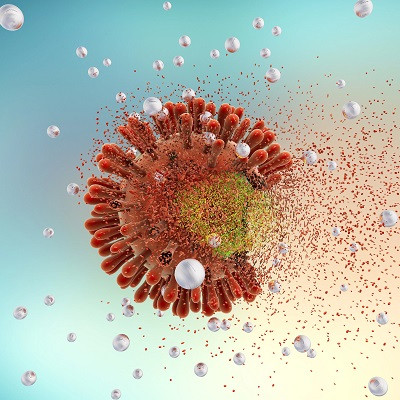
2021-06-30
Visited : 2822
Nanotechnology is widely employed in diagnostic and therapeutic applications both outside the body and in vivo. In particular, it is used in the form of biosensors and drug delivery agents, many of which are applicable in combating severe acute respiratory syndrome coronavirus 2 (SARS-CoV-2) infection. Nanomaterials additionally possess antimicrobial and antiviral properties when applied to physical objects, potentially aiding long-term in suppressing the coronavirus disease 2019 (COVID-19) pandemic.
In a review paper published in the open-access MDPI journal Viruses, a team of researchers explored the potential of nanotechnology to alleviate the current and future coronavirus burden. The team focused on its potential role in the detection, diagnosis, protection, and treatment of SARS-CoV-2 infection.
Biosensors
Nanoparticles can act as sensitive biosensors that indicate the presence of a molecule of interest in a sample colorimetrically or fluorimetrically. Currently, detection of SARS-CoV-2 in a sample requires extensive PCR amplification steps followed by detection by enzyme assay, while nanoparticle detection systems may allow these costly steps to be avoided. Colloidal gold nanoparticles, for example, absorb light most strongly at a particular wavelength of light, giving them their distinctive red color. Aggregation of these particles into clusters, induced by the presence of the molecule of interest via complimentary ligand binding, causes a recognizable shift in color towards purple, allowing them to act as a sensitive biosensor. The ligand bound to the particle may be an antibody or DNA that is known to form a strong bond with the SARS-CoV-2 spike protein or viral RNA, respectively.
Involving computational detection allows greater sensitivity than can be seen by the human eye, and similar detection systems have been developed with fluorescent particles that bind with the spike protein in a sample and allow detection following only 5 minutes of incubation, with no viral RNA amplification. Electrical biosensors that do not rely on colorimetric detection have also been developed, one utilizing the change in electric potential caused across a graphene sheet upon the binding of an immobilized SARS-CoV-2 antibody with the SARS-CoV-2 spike protein, providing highly sensitive detection.
Protection
Many nanomaterials are inherently antimicrobial and antiviral; metallic nanoparticles often express differing properties than their bulk counterparts. Silver and copper nanoparticles are well known for these properties, exerted through the generation of reactive oxygen species and by damaging the cell membrane of nearby pathogens. However, carbon-based nanostructures have also been seen to inhibit bacterial growth. For example, hydrophobic nanowhisker coating on a fabric surface prevents moisture adsorption and prevents bacterial adhesion.
Incorporating these technologies into commonly touched surfaces, face masks, and other personal protective equipment (PPE) could significantly reduce the transmission of SARS-CoV-2 by lowering the time that the virus can survive on such surfaces. Silver, gold, magnesium oxide, copper oxide, titanium oxide, and zinc oxide nanoparticles have each demonstrated an ability to be successfully used as a coating for many surface types, suppressing pathogen growth. Specific to SARS-CoV-2, copper nanoparticle-coated cardboard materials have demonstrated better suppression than otherwise commonly employed plastic or stainless steel implements in hospitals. Hydrophobic copper nanoparticle emulsions can be sprayed onto surfaces providing long-lasting protection to a wide range of materials, from wood to metals.
Therapy and Vaccines
Nanoparticle drug delivery systems generally offer greater retention time within the body than free drugs alone and greater target specificity thanks both to the high level of chemical customization possible to the nanoparticle surface and the innate physical properties of the particles themselves.
For example, nano-sized objects have a propensity to accumulate in areas of inflammation, becoming trapped and encouraging cell uptake in these tissues. This subsequently allows for a lowered frequency and volume of drug administration, resulting in fewer off-target effects. Drugs that are otherwise poorly bioavailable can be improved by incorporation into a nanocarrier. This allows them to better cross the intestinal membrane if administered orally and better cross the cell membrane into the target cell once in position.
Recently deployed COVID-19 vaccines utilize nanoparticle delivery systems, also acting as an adjuvant to stimulate an immune response in the case of the Moderna vaccine, which employs a chimpanzee adenovirus vector. The Pfizer vaccine instead uses liposomes as an mRNA delivery system, which can easily cross the cell membrane thanks to the lipophilic nature of the particle.
Future perspectives
While nanotechnology has advanced significantly in recent decades, many of the technologies described here are in their infancy, having only been deployed in a research context prior to the onset of the COVID-19 pandemic.
Nanotechnology-based approaches do allow for fast and precise diagnosis of SARS-CoV-2, however, in addition to allowing for the production of more effective PPE and disinfectants. Lipid nanoparticles are already utilized in the major COVID-19 vaccine to deliver mRNA successfully.
Future use could include the delivery of traditional antiviral agents or biomolecules that allow for protein editing and gene therapy. In vivo biosensors for SARS-CoV-2 could also be realized using nanotechnology, indicating the specific location and magnitude of SARS-CoV-2 infection in the body. This could be done through combining MRI with magnetic nanosensors, contrast-based imaging with dense particles of any material, or optical imaging using color- or fluorimetrically sensitive particles that are tagged with a SARS-CoV-2-binding ligand.
Read the original article on News Medical.